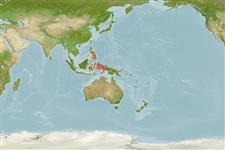Classification / Names
Common names from other countries
Main reference
Size / Weight / Age
Max length : 67.8 cm TL male/unsexed; (Ref. 82435)
Environment
Marine; reef-associated; depth range 4 - 10 m (Ref. 90102)
Climate / Range
Tropical, preferred ?
Distribution
Western Pacific: Philippines, Indonesia (Kaiman, West Papua), but likely to occur as far east as Rabaul, New Britain (based on an underwater photo).
Countries | FAO areas | Ecosystems | Occurrences | Introductions
Short description
Dorsal
soft rays
(total): 578-629;
Anal
soft rays: 390 - 432;
Vertebrae: 204 - 213. This relatively slender species has the following distinct set of characters: dorsal-fin origin anterior to gill opening; with pterygoid teeth; body depth at gill opening 28.8-35.2% of HL; preanal vertebrae 62-71 (mean = 65), total vertebrae 204-213 (mean 207.4) ; preanal lateral-line
pores 63-69; body colouration consisting of zebra-like black and white barring on head grading to complex black and white maze pattern on body (Ref. 82435).
IUCN Red List Status (Ref. 115185)
Threat to humans
Harmless
Human uses
More information
Common namesSynonymsMetabolismPredatorsEcotoxicologyReproductionMaturitySpawningFecundityEggsEgg development
Age/SizeGrowthLength-weightLength-lengthLength-frequenciesMorphometricsMorphologyLarvaeLarval dynamicsRecruitmentAbundance
ReferencesAquacultureAquaculture profileStrainsGeneticsAllele frequenciesHeritabilityDiseasesProcessingMass conversion
Tools
Special reports
Download XML
Internet sources
Estimates of some properties based on models
Phylogenetic diversity index
PD50 = 0.5000 many relatives (e.g. carps) 0.5 - 2.0 few relatives (e.g. lungfishes)
Trophic Level
3.4 ±0.4 se; Based on size and trophs of closest relatives
Resilience
Medium, minimum population doubling time 1.4 - 4.4 years (Preliminary K or Fecundity.)
Vulnerability
Moderate vulnerability (45 of 100)
Price category
